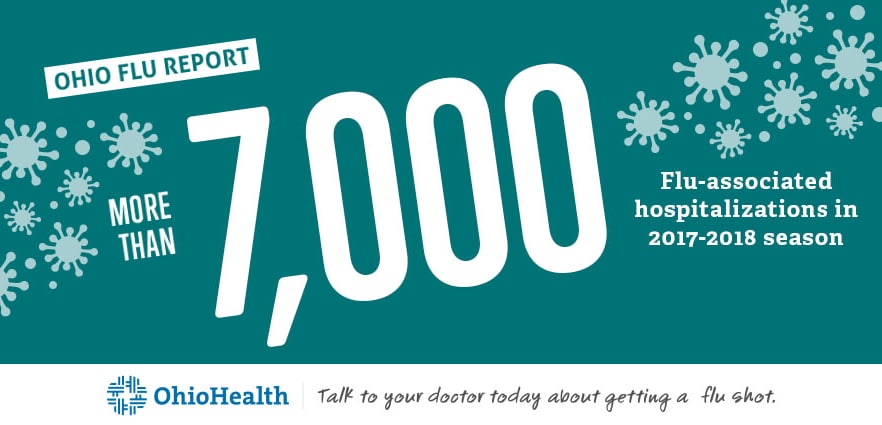Tips and Tricks to Stay Healthy this Flu Season
By: Amy Westfall, ANP
Between the months of October and February, everyone is vulnerable to the flu season. Flu season is the time of year when the flu is most contagious. Often businesses, schools, and workplaces will put in place precautions to prevent the spread of the virus, usually with flu shots, handwashing, or protective gear. Flu season is officially announced by the Centers for Disease Control (CDC) when there is a large spike in the number of recorded flu cases, but the flu can be contracted all year round. While there is no exact answer as to why winter months see a rise in flu cases, it is thought to be caused by colder weather (Duquesne University). On average, 8% of the U.S. population gets the flu every year. This percentage varies from year to year and depends if people that have the flu experience the symptoms (CDC.gov). According to Ohio Health, there were more than 7,000 flu-related hospitalizations in the 2017-2018 flu season.

Flu Statistics from Ohio Health Blog
The flu, also known as influenza, is a contagious virus that affects the nose, throat and sometimes the lungs. While easily prevented, the flu can sometimes be more severe leading to death. The flu can often be mistaken for a cold. However, unlike a cold, the flu starts suddenly with some or all the following symptoms:
- Fever
- Chills
- Cough
- Sore throat
- Runny or stuffy nose
- Body and muscle aches
- Headaches
- Fatigue(tiredness)
- Vomiting or diarrhea (more common in children)
During the first three to four days of the illness is when people are most contagious. Starting day one, before symptoms develop, a person may be able to infect others, and this can also last up to seven days after the beginning of symptoms. From the moment a person is infected, it can take between one and four days for symptoms to appear.
Some people are more vulnerable to complications when sick with the flu. Those age 65 and older, people with chronic illnesses (asthma, diabetes or heart disease), pregnant women and children under the age of five are more likely to develop other illnesses while infected with the flu.
Complications include:
- Bacterial Pneumonia
- Ear infections
- Sinus infections
- Worsening chronic medical conditions (Heart failure, Asthma, Diabetes)
How to diagnose the flu
It is often hard to tell the difference between the flu and other illnesses like viral or bacterial respiratory infections, based only on the symptoms. There are tests available to accurately diagnose if a person has the flu. “Rapid Influenza Diagnostic Tests (RIDTs)” are the most common tests. This test detects the part of the virus that makes the body respond. Results are given within 15 minutes. However, RIDTs are not the most accurate flu test. “Rapid Molecular Assays” is a more accurate flu test that detects the genetic material of the flu virus. It takes 15 -20 minutes to get the results. Specialized labs, such as those in hospitals and state public labs, have mouth or nasal swabs available to test, taking one or more hours. These are required to be administered by a healthcare provider (CDC.gov).
Treatment
Once diagnosed with the flu, there are a few different treatment options depending on the severity of the illness. Antivirals can be prescribed by a healthcare provider to combat the virus. This medication can reduce the severity of the symptoms and cut the length of the sickness by up to two days. Outside of antivirals, there are no other prescribed treatments. Those affected should rest and drink fluids (Mayo Clinic).
How is it spread?
The main way the flu is spread is by tiny droplets, produced when an infected person coughs, sneezes or speaks. Droplets can land on nearby people’s mouths and noses. A less common way the flu is spread is by touching an infected surface. The same droplets can land on doorknobs and other surfaces that are commonly used by multiple people. When this happens, if an uninfected person touches a contaminated surface then touches their eyes, mouth or nose they can contract the flu (CDC.gov). However, steps can be taken to prevent the flu.
Prevention
The most essential step to prevention is getting a flu vaccine every year. The vaccine has been proven to reduce the flu and related illnesses due to complications. Other preventive actions include staying away from those who are sick, covering coughs and sneezes and handwashing often (CDC.gov).

Steps to Prevent the flu Tri-anim
The Center for Disease Control recommends that all children above the age of six months, as well as adults, receive a flu vaccine. The vaccine is an intravenous injection, which is made to fight specific strains of the flu. Each year researchers create vaccines that fight the strain of the flu that is predicted to be most prevalent (Duquesne University). Vaccines are available at many health-related locations, like clinics, health departments and pharmacies, or commercial drug stores.
Hand washing
Hand washing is one of the best ways to stay healthy during flu season, along with the rest of the year. There are common times when hand washing is necessary, such as:
- Before and after preparing food
- Between the preparations of different foods
- Before eating
- Before and after taking care of a sick person, especially those experiencing vomiting and diarrhea
- Before and after treating cuts and wounds
- After using the restroom
- After changing diapers or assisting a child using the restroom
- After blowing your nose, coughing and sneezing
- After touching animals, animal feed or animal waste
- After handling pet food or pet treats
- After touching garbage
Handwashing not only protects the person washing their hands, but it helps protect the people around them. To ensure you are properly washing your hands follow these steps every time:
- Wet your hands with clean, running water. Turn off the tap and apply hand soap.
- Spread the soap by rubbing your hands together, making sure to spread it between your fingers, under fingernails, on the back of your hands and up your wrists.
- Scrub your hands for at least 20 seconds, again making sure to scrub both entirely. Humming “Happy Birthday” is a great way to make sure you are scrubbing for at least 20 seconds.
- Rinse your hands under clean, running water.
- Dry your hands using an air dryer or a clean towel.

How to wash your hands UCI Health
When you are unable to use soap and water, it is a good idea to use hand sanitizer. The best hand sanitizers contain at least 60% alcohol, which is clearly stated on the product’s label. While this is a quick substitute for hand washing, hand sanitizer does not get rid of all germs. This is also not the correct way to clean visibly dirty hands or remove chemicals from hands (CDC.gov).
Always speak to your provider about receiving a flu shot and other ways to stay healthy this flu season. To schedule an appointment for your flu shot, call AxessPointe today at 888-975-9188. For more information on AxessPointe visit
axesspointe.org
References
Duquesne University.(n.d). Retrieved November 27, 2019. From
https://onlinenursing.duq.edu/when-flu-season/
CDC.gov. (2019, September 13). Retrieved November 27, 2019. From
https://www.cdc.gov/flu/about/keyfacts.htm
Mayo Clinic.(2019, October 4). Retrieved November 27, 2019. From
https://www.mayoclinic.org/diseases-conditions/flu/diagnosis-treatment/drc-20351725
Ohio Health Blog. (n.d.). Retrieved November 27, 2019. From
https://blog.ohiohealth.com/ohio-flu-report-2018/
Tri-anim. (n.d.). Retrieved November 27, 2019. Form
https://www.tri-anim.com/Flu/default.aspx
UCI Health. (2017, September 28) Retrieved November 27, 2019. From
https://www.ucihealth.org/blog/2017/09/hand-washing





